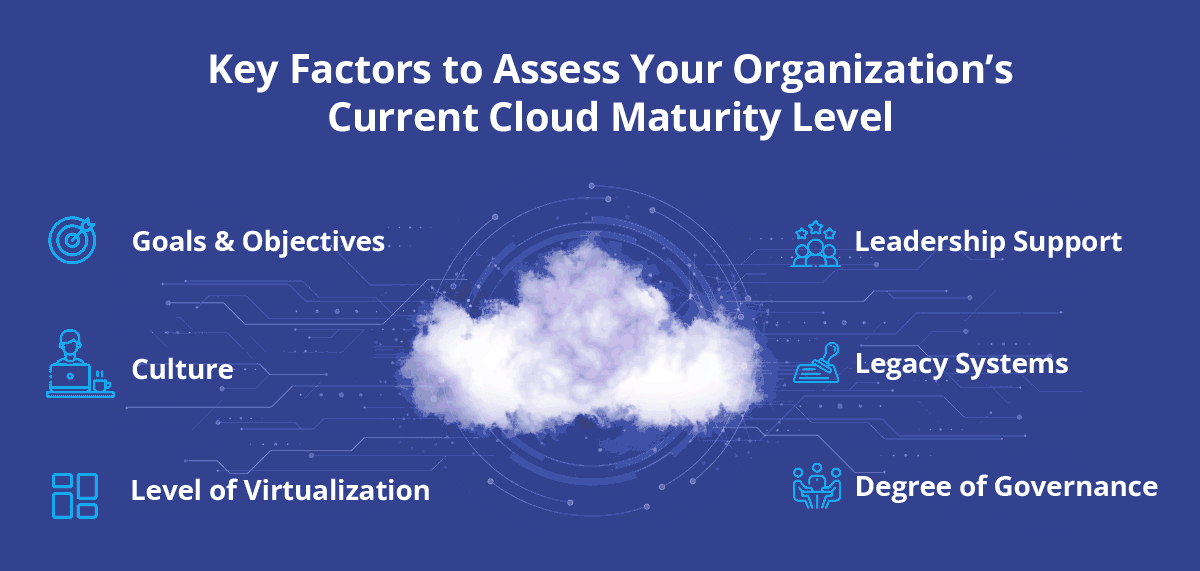



Today, every organization is relying on the cloud to carry out its business operations, whether in the form of collaboration apps, scalable storage, or outsourced IT services. But with widespread investments and interest in running operations on the cloud, this dependency on the technology is equally important.
Given how crucial technology has become for driving business results, the pressure to become fully cloud-enabled is only mounting.
Undergoing a cloud strategy assessment is a critical step to evaluating an organization’s readiness for cloud adoption. Migrating workloads to the cloud using a PaaS, SaaS or IaaS model or implementing a bunch of cloud-based apps comes later in the quest of achieving desired business outcomes for organizations looking to scale their business.
Cloud Assessment: Six Important Factors to Consider
The cloud is at the heart of all high-impact business transformations, delivering the agility enterprises need to craft new business models, customer experiences, and product offerings. However, many organizations struggle with adopting cloud technologies. Most roadblocks stem from strong beliefs in the well-established processes that enterprises have mastered for supporting their on-premises capabilities.
To successfully migrate to the cloud, enterprises need to first understand where they stand on the cloud maturity matrix. While some are functioning entirely on the cloud, many have migrated critical business systems and workflows to the cloud, and some are still weighing the pros and cons of cloud adoption.
Understanding whether your enterprise cloud maturity level is tactical, strategic, or transformational plays a huge role in optimizing your existing capabilities and steering future decisions towards boosting cloud infrastructure success and ROI. Here are some factors to help you assess your organization’s current cloud maturity level:
1. Goals and Objectives
One of the first things organizations need to understand about their cloud maturity level is the goals and objectives they are looking to achieve with the cloud. Is digital transformation required?
How will cloud strategy adoption help improve business efficiency? Are we looking to boost organization-level productivity? Are we looking at a product or service-based model with cloud-first customers in scope? These are some of the questions that require definite answers to proceed.
2. Culture
Another key to cloud infrastructure success is having the mindset to achieve the set goals. Cloud adoption is more than just a technical transformation. It is driven by a shift in culture and a change in mindset that impacts all things cloud—planning, cost structures, execution, training, and more.
Does your workforce understand the need to become a cloud-first organization? Are they aware of the benefits the cloud infrastructure can bring to your bottom line? Are they ready to embrace new ways of working? Get to the bottom of it before embracing the cloud.

3. Legacy Systems
The presence of legacy systems is another barometer that can be used to assess your cloud maturity. Organizations that are heavily reliant on legacy systems are usually laggards when it comes to cloud adoption.
Conversely, those that leverage modern systems, serverless architectures, and containerized applications to run their business are easily able to integrate the cloud strategy into their daily operations and use it to accomplish their long-term goals and objectives.
Read Blog: Serverless Computing Can Propel DevOps to New Heights
In the last three years, many organizations have taken a microservices and containerized approach. Therefore, those looking to capitalize on trends like instrumentation and observability must first modernize their legacy ecosystem to drive cloud success.
4. Level of Virtualization
As a fundamental technology that powers cloud computing, the level of virtualization across your business is a critical indicator of where you lie on the cloud maturity model. Make sure to evaluate the level of virtualization you have enabled— hardware, operating system, library support, user application, or instruction set level—to get a deeper understanding of your cloud maturity level.
5. Leadership Support
The amount of executive sponsorship and leadership support you have for cloud implementation defines your cloud maturity level. For instance, organizations that are just experimenting with cloud technology have little or no support from the top level and lack a robust cloud adoption strategy.
On the other hand, organizations that have integrated the cloud into the very foundation of their business usually have cloud initiatives led by C-level executives that ensure all cloud decisions are inextricably linked to their current business processes and future goals.
6. Degree of Governance
Poor security and governance mean you’re still at a nascent stage of cloud maturity. On the other hand, strategies and measures that help automatically fix, right size, or terminate workloads that do not meet standards or guardrails that enable the automatic implementation of security best practices or monitoring of violations. This signify that your cloud infrastructure approach is defined and systematic.
Read Blog: Cloud Security Best Practices & Assurances To Seek From Your Vendor
Organizations that embark on the cloud adoption journey often assume that once they’re in the cloud, the benefits will offset the costs and risks. What they don’t understand is that cloud success comes with a deep understanding of their current cloud maturity.
Being cognizant of existing cloud maturity throws much-needed light on the organization’s readiness for utilizing cloud services and helps in making the journey to the cloud as effective and quick as possible, all while ensuring cloud services are in line with business objectives.
Bottom Line
Irrespective of the stage of cloud maturity your organization is at, it is essential to constantly monitor, analyze, and manage your cloud journey using a modern Cloud Observability and Management Platform. Leveraging pre-built analytics and automation, such a platform will provide full-stack visibility into your current level of cloud maturity and enable you to address people, process, and technology issues as you advance along your journey.
Xoriant can help you accelerate your digital transformation efforts through the correct implementation of cloud services technology.
Check out our related PDF: XCMD
Enable, secure, and optimize cloud infrastructure workloads with Xoriant






 View Previous Blog
View Previous Blog




